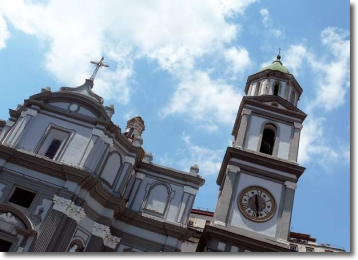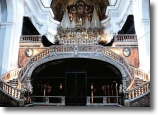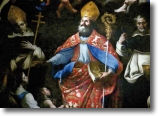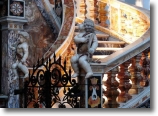Warning! The template for this page [TurismoCultura.html] doesn't exists.
Basilica of St. Maria della Sanità

We arrived to the square of Sanità [Sanità means Health]; this name was brought to this valley hill for this beneficial air or from many miracles obtained on the graves of saints buried in their adjacent crypts. Here, lies the big basilica of Santa Maria della Sanità, under which there's the catacomb of St. Gaudioso. This holy bishop of Abitinia, expelled from Africa, came in Naples with St. Quodvultdeus, Primate of Carthage, and other African exiled...
Gaudioso died and was buried in a crypt of this valley, where also had been buried St. Nostriano, our bishop; closely their tombs rose the cemetery and Neapolitan began to venerate the tomb of St. Gaudioso equally such as San Gennaro... but in the ninth century... the body of saint Gaudioso and other bodies were transported into the city, and buried in the church of San Gaudioso at Caponapoli except St. Nostriano, in fact he was placed in the church S. Gennaro all'Olmo; then the church and the extramural cemetery were almost abandoned, until the church was covered with alluvial earth.
In the sixteenth century... it was decided to open this place at the people worship, and many people began to obtain many graces by the Mother of God ... The administration of this place was given to the fathers Preachers... and they built the magnificent temple with the bizarre drawing of the lay Dominican fra' Giuseppe Nuvolo... he didn't destroy the old church and cemetery but, with new and astonishing idea, placed upon them the new altar and, in front of it, the majestic temple of elliptical shape with five naves; the church remaining at the center of the hill, he built the monastery on the hillside... This church is one of the seven [Neapolitan] churches to which Innocent XII granted the indulgence of the seven Roman basilicas.
Entering the Church is beautiful to see the altar upon the ancient church.On the right, in the first chapel, you can see the picture of San Nicola with St. Ambrogio and St. Ludovico Beltrando of Luca Giordano; in the second chapel the San Pietro Martire of Giovanni Balducci; in the third chapel the picture of San Vincenzo of Luca Giordano [on the right the Madonna della Sanità, realized in the fifth century, on the pillar there is the work of Anna Maria Bova "San Vincenzo" of 2009]. In the big chapel there is the picture of the Holy Rosary, on the sides there are small compartments and under it the painting of the Condemnation of the Albigenses by Bernardino Siciliano; in the fourth chapel is painted the marriage of St. Caterina Martire by Andrea Vaccaro; in the fifth St. Caterina receiving the stigmata by Andrea Vaccaro; in the sixth St. Domenico Soriano painted by Giordano [actually the chapel is dedicated to Madonna del Buon Consiglio because Giordano's work has been lost]. On the left nave, in the first chapel there is the picture of St. Biagio con Antonino Pierozzi e Raimondo di Pennafort by Agostino Beltrano and his wife Annella de Rosa [the "Croce" of 2008 is a work of Anna Maria Bova]; in the second chapel, the Holy Virgin with St. Rosa and St. Giacinto who received the inscription "gaude fili my hyacinte" by Giordano; in the third chapel there is the Annunciate by Bernardino Siciliano [in the ovals two Gaspare Traversi's works]; in the big chapel the Circumcision by Vincenzo Forlì [on the left the picture of St. Lucia by Girolamo De Magistris]; in front of the door of sacristy there is the picture of San Pio con i santi dominicani by Giordano [at the moment the work is located in the chapel of Madonna del Buon Consiglio].
In the Sacristy upon the altar there is the picture of St. Domenico [painted by Giovanni Balducci, actually is located in the big chapel of the Circumcision, in the sacristy today there is "L'ultima cena", painted by Gianni Pisani in 2008]. In the penultimate chapel there is a Pacecco de Rosa's picture of St. Tommaso with angels holding the girdle of chastity, in the last chapel the Maddalena painted by Giordano. At the left of the altar of St. Tommaso set in the ancient wall the pontifical chair, which was first in the cemetery, used by the ancient bishops San Nostrano, S. Gaudioso and others; we can see a carved monogram of Christ. Look now at the marble pulpit, performed with rare invention by Dionisio Lazzari, which are also the two majestic staircases that lead up to the great altar, where a shrine of rock crystal and gilded copper, made from the dominican friar Azaria from Naples, the chorus has eighty seats and it is exquisitely worked, upon the organ there is the marble statue of Vergine della Sanità, a work of Naccarino [in the middle of the central nave today are located two works of Riccardo Dalisi, "la Mensa degli Angeli" of 2005 and "Palestina" of 2000].



